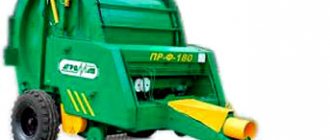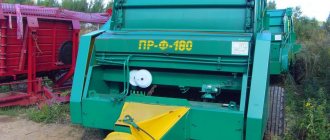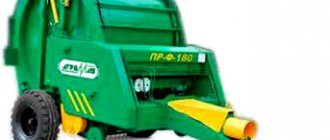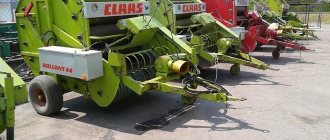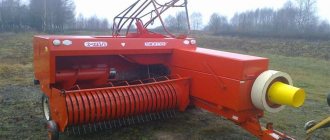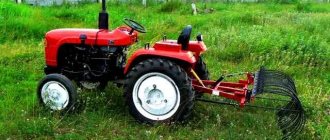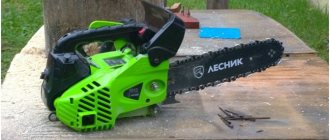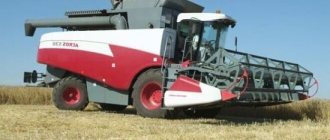Purpose and scope of application
“You need to make hay while the sun is shining” - everyone involved in agriculture should follow this principle from year to year. After all, when the time comes to prepare feed, you need to make the most of the favorable weather. Otherwise, if you miss the right moment, the quality of the feed will inevitably suffer.
The productive John Deere 550 roll picker will help you harvest and prepare forage crops in the shortest possible time, while the humidity level is at an ideal level for this, and rain clouds are somewhere over the horizon, “on the way.” It picks, bales, shapes and wraps one perfect bale of hay after another, and gets the job done as quickly as possible.
The increased density of the surface layer of the bale, but at the same time the looseness of its inner part, allows, by maintaining good air permeability, forage to dry out and be preserved better, while at the same time remaining high-quality and nutritious.
The baler is designed for collecting and pressing windrows of dry and (or) cured hay into rolls; straw (including chopped), followed by wrapping the roll with twine or packing it in a net. The baler is aggregated with tractors, most often of traction class 1.4, equipped with a PTO, hydraulic drive, pneumatic brakes and a socket for connecting electrical equipment.
How the bale press works
The mown mass is collected using tines located on the shaft compartments. The processing of hay and straw with a bale unit is carried out using a piston, which compresses the mass with reciprocating movements in special compartments. At the same time, it is possible to adjust the length of the bales.
The processed mass is packed into rectangular blocks, which are firmly tied with twine. A square baler allows you to form a crop collected in several bales into one dimensional block. During operation, the unit can cover an area of 2 to 2.5 meters without obstructing the view of movement.
If foreign objects get into the press or if there is excessive accumulation of mass, all the excess passes through the pulley. This allows you not only to form high-quality bales with the same amount of hay, but also protects the drive from damage.
The square baler is controlled directly from the tractor cab.
Design Features
The design of the John Deere-550 is quite simple, without unnecessary and rarely used components. Experience shows the exceptional strength and reliability of the welded frame, which was originally designed to work in an intensive rhythm and under increased loads. The small width of the baler ensures a consistently uniform flow of plant material into the bale chamber. As a result, dense rolls of virtually ideal shape are formed.
Rolls of different diameters, tied with double twine or mesh
"John Deere-550" is equipped with a low-profile pick-up, which is located as low as possible to the ground when moving, capturing almost all the feed material without any residue. The rotating fingers on its toothed feed mechanism lift, rather than push, the roll from below toward the bale chamber opening.
A smooth and even flow of plant material ensures that there is no loss of foliage from the stems and the quality of the forage remains high. This is especially important when harvesting short-stemmed plants. And the impressive diameter of the auger, designed taking into account the experience gained in the production of headers for John Deere combines, allows all work to be done at high speed.
This is a baler with a variable volume pressing chamber. That is, the “last word” in preparing rolls of the required diameter remains not with the equipment, but with the machine operator. The hay bales will be formed to the diameter and density they set. The 550th model is characterized by a fast and confident start to bale formation.
Once the material enters the bale chamber and begins to rotate counterclockwise, belts with a diamond-shaped surface pattern form the center of the roll. As feed continues to flow into the chamber, the reinforced tension arm applies the pressure required
which is chosen by the machine operator. Twin hydraulic cylinders maintain this selected belt pressure throughout the subsequent tying process. The result of the work is visible immediately. Tying is done with double twine and gives quick and reliable results.
In addition to twine, the John Deere 550 baler can also tie formed bales with a special mesh. The mesh, in addition to the side surface of the rolls, also reliably protects their edges.
Belts, rollers, bearings
Wide belts with a diamond pattern cover more than ninety percent of the bale width, reducing the possibility of feed loss, and guaranteeing an easy and quick start to the bale formation process. A special cleaning auger keeps these belts clean and in good condition. Thanks to this, they do not lose the quality of adhesion to the feed mass, even when it comes to working with moistened material.
Diamond-shaped belts are three-layer. The first layer is made of polyester and nylon and gives strength to the belt. Four rubber gaskets between the polyester and nylon isolate one material from the other. Nylon fabric in the center prevents the belt from stretching under increased loads. The flat inner layer glides smoothly over the rollers without heating up. Each layer is covered with rubber coating.
Two standard drive rollers provide the necessary movement. And the third drive roller is used for intensive formation of silage rolls. Under difficult conditions of working with wet material and preparing silage rolls, the cross auger reliably protects the belts from contamination. Roller bearings are located in such a way as to protect them from all possible aggressive influences from the outside.
Like other variable-volume bale chamber round balers, the John Deere 550 baler is equipped with flat belts and a belt tensioner. Together they rotate the bale in a uniform rhythm, ensuring the required density of the feed mass from the center to the edges. To increase the knitting density of the roll, the gearbox transmits increased power. Thanks to its large feed opening area and unobstructed feeding technology, the John Deere 550 baler provides consistently high throughput - especially needed when working with dry forage crops.
If the baler becomes clogged, the lower chamber guard can be lowered to start working again in just a few seconds.
Transmission
The transmission on John Deere-550 balers has constant velocity joints with automatic return to their original position. As a result, power is used more efficiently. Excessive vibrations are eliminated. The operator can make turns at an acute angle, up to eighty degrees.
Technical specifications in numbers
- Roll diameter – from 0.6 to 1.83 m.
- Roll width – 1.17…1.20 m.
- Roll height – 1.20 m.
- Roll weight is from 80 to 450 kilograms.
- Baler width – 1.8 m
- Working width – 1.4…1.6…2.2 m.
- The weight of the baler is 1.9 tons.
- The required PTO (power take-off shaft) is 44 kilowatts.
- The required minimum tractor power is 40 horsepower.
About quality and wear resistance
In addition to the exceptional strength of the baler frame and the design of its bale chamber as a whole, there is one more point that cannot be ignored, especially in comparison with Chinese-made agricultural machinery. This is a time-tested high quality metal that is not subject to corrosion for a long time. And also – high-quality painting of the body.
It’s easy to see that the vast majority of John Deere 550 balers offered for sale on the secondary agricultural machinery market retain their “native” green factory paint even after eight or ten years. Which almost never peeled off or peeled off.
Overall, this is truly a highly reliable and productive agricultural machine, about which it is difficult to find even one negative review.
Hay baler for walk-behind tractor
Heavy walk-behind tractors used by agricultural enterprises are practically not inferior in their capabilities to small mini tractors. For such equipment, installing a round or square baler can significantly expand the technical capabilities and application options.
When choosing a unit for installation on a walk-behind tractor, you must pay attention to the following parameters:
- Equipment performance. If you plan to use the baler in areas of limited area, as well as for aggregation with an existing walk-behind tractor, this parameter is decisive.
- Complete set of equipment, the presence of such useful functions as a knitting machine.
- The useful volume of the chamber determines the maximum size of the bale or roll available for pressing and tying.
Most balers for walk-behind tractors are of the round type. Due to its affordable price, the equipment is in demand in small farms and livestock farms. Ease of operation, the ability to install on various types of equipment, wear resistance and excellent technical characteristics determine the demand for this type of product. In most cases, any malfunction can be fixed on your own, which further increases the popularity of such equipment.
Cost of a used John Deere-550 baler in 2018
As already noted, this model was withdrawn from the range of products manufactured in the 2010s, and therefore it can only be purchased in a used version. There are not many offers for sale, and not all regions of Russia and the CIS have them.
All these are cars produced 8, 10, 15, even 20 years ago, but, judging by real photographs, they are in decent working condition. The minimum price asked for a used John Deere 550 model baler is 270 thousand rubles. Maximum – 450 thousand rubles. The most common price quoted by the owners of these balers in various regions of the former Union is located in the middle of these values and amounts to 350-380 thousand rubles.
What is this?
These devices allow you to collect straw or hay, compress it and form the mass into bales and rolls. Previously, all these operations were performed manually. The work took a lot of time and required an impressive human resource.
Thanks to machines such as a baler, the job requires one agricultural unit, a tractor to which the picker is attached, and one operator. In a few hours you can process several hectares, minimizing financial and time costs.
